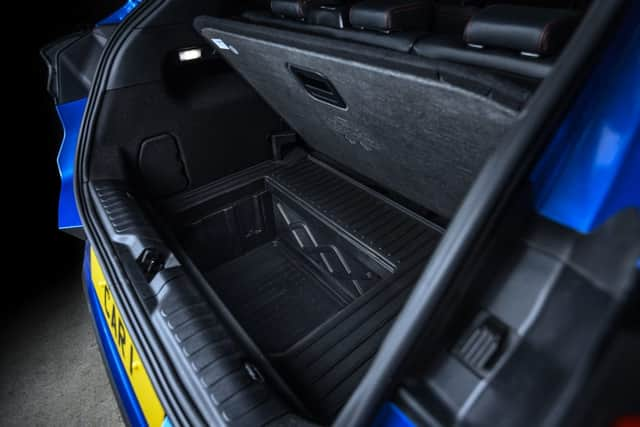Ford Puma review


For quite a few years the B-SUV segment was a fairly bleak corner of the automotive world. After replacing family hatchbacks with SUVs, car makers decided that superminis also needed a jacked-up, “rugged” looking equivalent and churned out a variety of models that ranged from the dull to the downright dreadful.
However, the last few years have seen manufacturers get their act together and as the segment has soared in popularity, the offering has improved markedly. It’s also expanded so now runs from budget-conscious, practical models like the Renault Captur and Kia Stonic to more expensive, style-focused fare like the Toyota C-HR and latest Nissan Juke.
Advertisement
Hide AdAdvertisement
Hide AdInto this arena strides the Ford Puma which looks to blend the striking styling and higher-end spec of more expensive models with the practicality of more mainstream examples, all while casting a deep shadow over its cheaper, duller EcoSport cousin.
Launched last year, the Puma revives an old Ford name but is really closely related to the Fiesta. It’s going up against the likes of the C-HR, Juke, Honda HR-V and Mazda CX-30 with prices closer to a C-SUV but the space of a B-SUV.


Ford Puma ST-Line X
- Price: £24,420
- Engine: 1.0-litre, three-cylinder, turbo petrol, 48V mild hybrid
- Power: 153bhp
- Torque: 177lb ft
- Transmission: Six-speed manual
- Top speed: 124mph
- 0-62mph: 8.9 seconds
- Economy: 40.9-54.3mpg
- CO2 emissions: 101g/km
Like some of those, the Puma’s looks are less conventional than “regular” B-SUVs and depending on your point of view are either bold or problematic.
The styling, with a deep gaping grille and huge headlights mounted high up on the car is definitely bold but I’m not sure it can be called attractive. The Puma looks better in the metal than in photos but while the high beltline and sweeping roof work to create a more coupe-like silhouette, that bulging “face” is hard to love.
Advertisement
Hide AdAdvertisement
Hide AdInside, it is more conventional, borrowing heavily from the Fiesta. That means a sensible, user-friendly layout but a design that seems dull compared to both its exterior looks and the interiors of key rivals. Materials are a mix of familiar Fiesta finishes along with some higher-grade touches on the doors, dash and seats, including leather on our ST-Line X car.
Despite being Fiesta-based, there’s fairly good passenger space in the Puma and you can squeeze five in if you need to. That gives it an advantage over some rivals which really are only good for four.


Its other advantage and much-publicised party piece is its luggage capacity. Thanks to the comically named Megabox the Puma offers up to 456 litres of boot space. The Megabox is a deep plastic-lined bucket hidden beneath the boot floor. The floor panel can be tucked out of the way, exposing the 80-litre waterproof box and creating a tall storage space or somewhere to stash damp outdoor gear.
In terms of equipment, the Puma is pitched to offer a generous level of kit in keeping with its slightly higher price tag. Standard wheels are 18 inches (ours were upgraded to 19s), there’s auto air con, an eight-inch touchscreen with smartphone mirroring, wireless charging and a sharp 12.3-inch digital instrument display. Standard safety kit includes autonomous emergency braking with pedestrian/cyclist detection, post-collision braking and lane keeping aid. The optional driver assistance pack (£900) adds enough acronyms to fill a Scrabble bag, including adaptive cruise control, blind spot alert with active braking and evasive steering.
Advertisement
Hide AdAdvertisement
Hide AdOptions fitted to our car added £4,000 to the list price and included fancy paint, a powered hands-free tailgate, LED headlights and an opening two-section panoramic sunroof.
It’s clear when you drive it that the Puma is based on the same platform as the Fiesta. Like the Fiesta, it’s the best-handling car in its class and could even be called fun to drive - not something every rival can claim. The taller, heavier Puma clearly isn’t as dynamic as the Fiesta but, aided by our car’s sports suspension, it can hustle along a B-road with more engagement and control than you might suspect, without compromising on comfort.


That’s helped by a fairly powerful drivetrain. Our test car featured the highest-rate 153bhp 1.0-litre EcoBoost petrol. It’s a mild hybrid, adding up to 37lb ft of torque at low revs, and the Puma has decent pace to go with its decent handling. Ford claims you’ll see up to 54mpg, which isn’t beyond the realms of possibility if you drive sensibly.
If you want more pace than that, the Puma ST will be along later this year with the 199bhp engine from the brilliant Fiesta ST.
Advertisement
Hide AdAdvertisement
Hide AdThe Puma is a marker of how far this segment has come in recent years. The styling is love it or hate it but if you can get on board with that the Puma offers an engaging drive, good equipment and family-friendly practicality along with those individual looks.